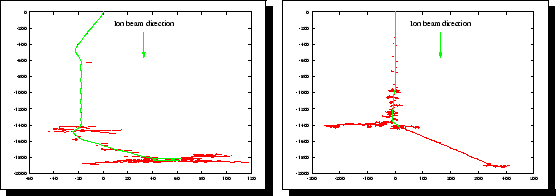 |
Whenever an energetic particle interacts with a stable atom of the target material, energy is transfered to the target atom. If the transfered energy exceeds the binding energy of the solid atom it is removed from its lattice position and a mobile recoil is generated which also penetrates deeper into the target and generates further recoils. By this process a recoil cascade is generated which contains the more particles the higher the energy and the larger the mass of the ion which initiates the recoil cascade. Fig. 3.10 shows two typical collision cascades.
 |
As a consequence of the collision cascade point defects are generated in crystalline target material. When a recoil is generated an empty lattice site (vacancy) remains behind and when the recoil comes to rest it is located in between regular lattice positions (interstitial). These point defects accumulate during the implantation process and influence the trajectories of later implanted ions, because the crystalline order is locally destroyed. If the number of point defects is very high a crystalline material converts into an amorphous state.
Two approaches are used to model the generation of point defects during the implantation. On the one hand side the rigorous but computational intensive Follow-Each-Recoil model and on the other hand side an analytical modified Kinchin-Pease model can be considered.